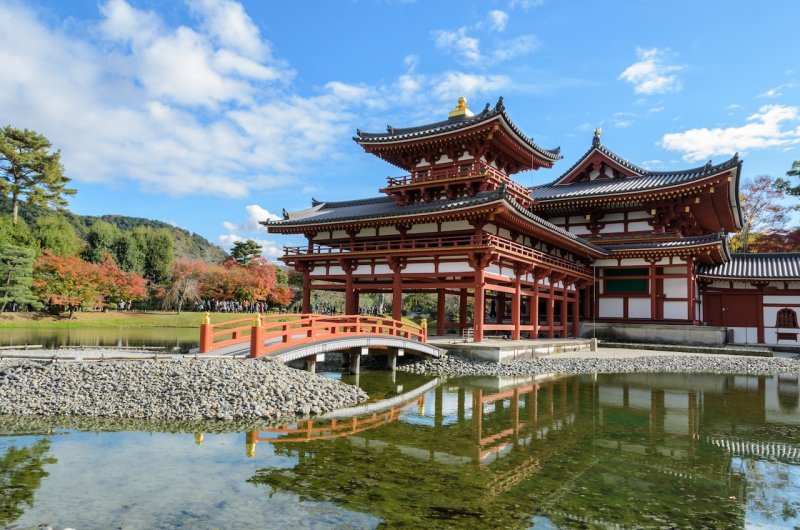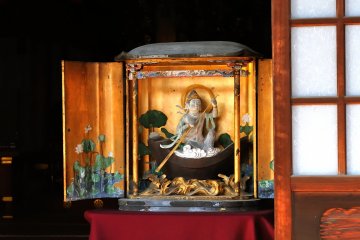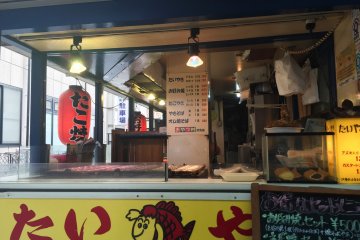
Обновлённый Зал Феникса в Бёдо-ин
Masayoshi HiroseЯ не спеша насладился видами освеженного прекрасного Зала Феникса.

The Byodoin Temple in the city of Uji near Kyoto adorns the reverse of the Japanese 10 yen coin and is best known for its distinctive “phoenix hall”. The original building was built in 998 as a nobleman's villa and later by a member of the then Influential Fujiwara clans acquired and converted into a temple.
Over the centuries the temple complex has been expanded and expanded, among other things, by the phoenix hall, inside of which there is an Amida Buddha statue and which thus forms the heart of the temple complex. Even if its official name is Amida Hall because of this statue, it is mainly referred to as the Phoenix Hall because of the representations of the Chinese firebird on the roof.
The Byodo-in Temple has been a UNESCO World Heritage Site since 1994 and is a popular tourist destination because of its special architecture and the surrounding garden. Visitors can also admire the interior of the hall on a guided tour.
10-minute walk from JR Uji Station on the JR Nara Line 10-minute walk from Keihan Uji Station on the Keihan Railway Uji Line

Я не спеша насладился видами освеженного прекрасного Зала Феникса.


Популярные японские пряники в форме маленьких рыбок называются "тайяки", буквально это переводится, как "испеченный карась". В этом маленьком, но невероятно популярном и оживленном киоске под названием Ояцумура в Отэсудзи, популярный торговый центр находится в Фусими, Киото, вы сможете насладиться этой вкусной японской закуской под названием тайяки. Тайяки в этом магазинчике идут с двумя классическими японскими начинками – сливочный заварной крем и адзуки или паста из красных бобов.

Located in Uji, the city renowned for green tea, Ujigami shrine is Japan’s oldest existing shrine. Among the country’s thousands of shrines, Ujigami shrine was one of the first — allegedly built during the year 1060. Although the shrine is rather off the beaten track, its convenient location makes it easy to combine visits with nearby Byodo-in Temple and Uji-gawa Shrine. Ujigami-jinja’s grounds are quiet and serene, located away from the bustling tourist attractions in central Kyoto. It was originally built to honor Emperor Ojin and his sons, after one of the princes committed suicide in a selfless effort to solve the dispute over imperial succession. Now, Ujigami shrine also serves as the guardian shrine for Byodo-in Temple. Visitors to Ujigami-jinja will also notice the abundance of rabbit motifs. The puzzling presence of rabbits is related to a myth about a divine rabbit that guided the lost prince back to town. Since then, the rabbit has been honored in the form of figurines, omikuji and more in the city of Uji. The temple’s springwater is said to have special qualities, making it the best choice for use in traditional tea ceremonies — rated to be among the 'Seven best waters of Uji'. Its main Honden building is also believed to be the oldest remaining example of nagare-zukuri-style architecture. Being host to such historically significant sites, it is no wonder that Ujigami-jinja was designated a UNESCO World Heritage Site in 1994.

Ōbaku-san Manpuku-ji is a temple located in Uji, Kyoto. It is the head temple of the Japanese Ōbaku Zen sect, named after Wanfu Temple in Fujian, China. The mountain is likewise named after Mount Huangbo, where the Chinese temple is situated. [Wikipedia]

Founded in 874, Daigo-ji Temple is one of Kyoto's most scenic religious sites. The hillside temple grounds make it a prime spot for cherry blossom and fall foliage, and its traditional buildings add to the rustic charm of the landscape. The main temple grounds are located is at the foot of the mountain and is connected to several other temple buildings around the summit via a hiking trail. The Daigo-ji also plays an important role in the Shingon sect of Japanese Buddhism. Its main buildings are home to dozens of valuable cultural artifacts, which has resulted in the Daigo-ji Temple being named a World Heritage Site by UNESCO. The main area of the temple is home to the Reihokan Museum, which preserves and exhibits the temple's vast collection of historical documents and art objects, including statues and paintings.